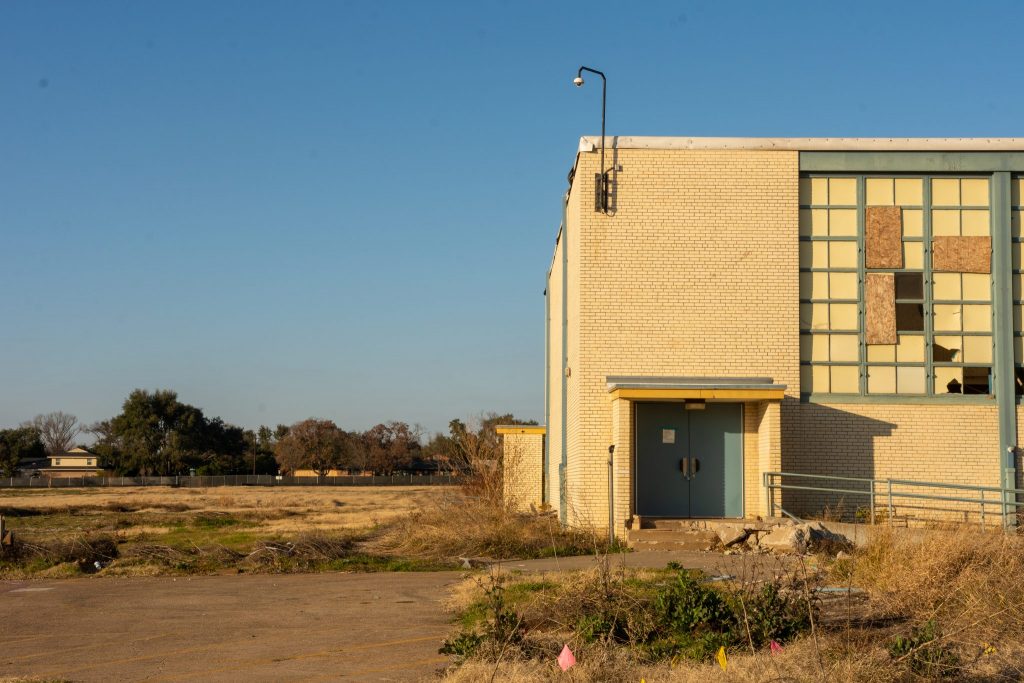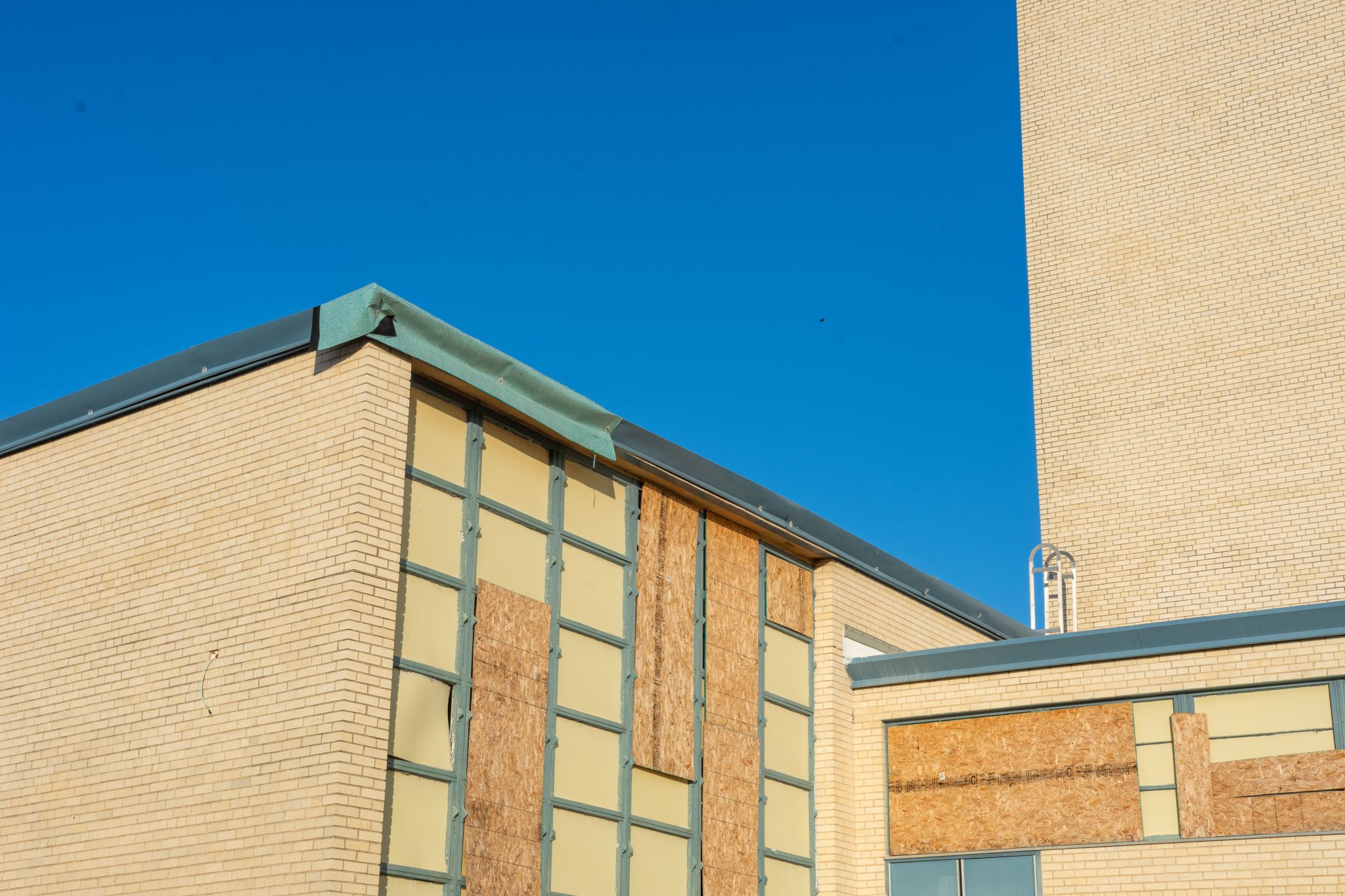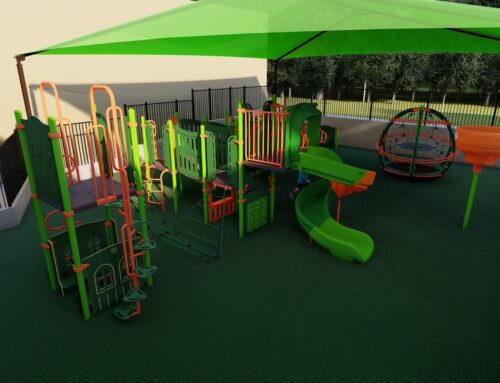
Photography by Carly May
Drive by Thomas Jefferson High School and there are still boarded-up windows and debris littering the campus from an EF-3 tornado that destroyed the school more than a year ago.
The holey roof provides no protection from the rain that seeps into the ruinous building—rotting wood, rusting steel and cultivating a damp environment where mold can grow. Well-meaning neighbors dump pounds of cat food for the feral cat colony that now calls the school home.
Despite calls from Thomas Jefferson alumni to scrap the building and rebuild a new high school—projected to cost $147.3 million—it will be heavily renovated from whatever remnants can be salvaged.
“I wonder about the quality of renovations,” neighbor Courtney Fadley says. “It’s sat for so long. I can’t imagine the mold. I can’t imagine what it looks and smells like in there. I don’t know how they’re going to turn it into a clean and safe learning environment.”
Thomas Jefferson was one of three Dallas ISD schools heavily damaged in the October 2019 tornado. Nearby Walnut Hill Elementary and Cary Middle School were totaled in the storm.
The Dallas ISD Board of Trustees approved $132 million in construction projects for the sites, with $82 million allocated to renovate Thomas Jefferson within its existing structure. The cheaper option allows DISD to build a new pre-kindergarten through eighth-grade campus that combines Walnut Hill and Cary Middle School on the former Cary site.
District officials hoped the projects would be completed by the start of the 2022-2023 school year. But in August, the board canceled a construction contract for the projects after corruption allegations. Superintendent Michael Hinojosa says that could delay the schools’ reopening.
The Thomas Jefferson, Cary Middle School and Walnut Hill sites are still a long way from what DISD envisioned. Stay up to date on their progress.

Thomas Jefferson
The fate of the 64-year-old campus was perhaps one of the most hotly debated items after the tornado.
Edwin Flores, the Dallas ISD Board of Trustees member for District 1, had hoped the board could reach a compromise between renovations and rebuild. He proposed a $124.6 million plan that would have demolished more of the school and renovated just a small portion. But some board members were at odds with the plan to spend more money on a rebuild when renovations could transform a school, like they did at South Oak Cliff in January 2020.
South Dallas board members Joyce Foreman and Maxie Johnson reminded the board that when funds were being allocated for South Oak Cliff, the community had to fight for its $52 million, about $40 million more than the original amount. Flores was one of three board members who voted against increasing funding.
The board voted 6-3 in favor of the renovation at Thomas Jefferson.
“I thought [Thomas Jefferson] merited a full replacement, but the board voted, and that’s all we can do,” Flores says.
The district has hired a new contractor for Thomas Jefferson and the adjacent K-8 campus, but the next few years will be challenging for students and educators. The community hopes to ease that burden by offering its support. Northway Church, located across the street from Thomas Jefferson, has partnered with the school since 2011. Each year, the church organizes a back-to-school event that provides attendees with backpacks, health screenings and family portraits.
Congregant and photographer Jeff McWhorter led a small group at the church that also adopted the school’s soccer team. They hosted team dinners and became super fans who attended all the games.
“We saw the fruit of that groundwork because when the tornado happened, we already had a relationship with the school,” McWhorter says.
Three days after the tornado, which also destroyed Northway, the church organized a family dinner in the parking lot. Church members and high school students, who had spent all day picking up debris, “just sat out there in the parking lot, sharing the solidarity,” McWhorter says.
The church has maintained its support for the school, temporarily located 9 miles away at Thomas Edison. Volunteers installed 130 IKEA shelves in classrooms to provide students with more storage. They also donated meals during the pandemic.
“We’ve been a bit involved in the rebuild process,” McWhorter says. “We’ve been a voice that lets the administration know we care about the kids. We want them to have something great.”
Cary Middle School

The idea to merge Cary Middle School and Walnut Hill into a K-8 campus was a homegrown idea.
After joining DISD in 1946, Walnut Hill become known as one of the best elementary schools in the district for its dual-language program and national awards, such as the National Blue Ribbon granted by the U.S. Department of Education.
Many Walnut Hill parents wanted their children to continue in the dual-language program beyond elementary school, but it was not offered at Cary. So, prior to the tornado, a group of parents approached Flores about creating a K-8 campus. The plan was fast-tracked after the twister damaged both schools.
The new campus will be a transformation school called the Walnut Hill International Leadership Academy. Transformation schools offer specialized programming like magnet schools, but without the entry requirements. The schools do not have attendance zones, and anyone can apply.
“I am excited [for my kids] to be able to continue through middle school,” Fadley says. “Some parents are really excited about it because it is a convenient middle school option in our area. Others aren’t excited about the age gap.
Some people see middle school students as a threat. As educators work, they would leverage that, and the middle-schoolers would be mentors. The thoughtfulness behind it will come into fruition.”
Fadley had a kindergartener in the dual-language program at Walnut Hill before the school was relocated to Tom Fields Elementary after the tornado. She has two other children who will someday attend the school.
“[My son] had started to feel confident [at Walnut Hill] because he knew where things were in the building,” Fadley says. “He struggled a little bit more with confidence after the tornado. The school is completely gone, but being [at Tom Fields] with the same people who were there is a game changer.”
Prior to the tornado, most students attending Walnut Hill lived outside the attendance zone, Flores says. Parents and students sought Walnut Hill’s celebrated programs, and many more may do so when the new school is complete.
Fadley, who lives in the Walnut Hill and Cary attendance zones, wonders what will happen to the community that already lives within the boundaries, especially the Cary boundary. Will they still have access? Will admission be difficult? Where will they go if the school becomes full?
Per DISD policy, open enrollment at the school will continue. If it becomes full, students will be selected for enrollment through a lottery to ensure diversity.
“Walnut Hill is going to be OK,” Fadley says. “The teachers are exceptional, and the community attending it is amazing.”
Walnut Hill
The district plans to restore salvageable portions of Walnut Hill and build an addition to create a high school campus called the Walnut Hill Career Institute, according to a zoning change application filed with the City of Dallas.
The institute would provide half-day specialized instruction in eight fields: aviation, construction and carpentry, electrical and solar technology, interior design, HVAC and refrigeration, plumbing and pipefitting, advanced mechatronics manufacturing and cybersecurity.
Students would arrive on campus for a morning or afternoon session via bus from their home high school. Walnut Hill Career Institute would not cover core curriculum, which would be taught at students’ home high schools. Additionally, fine arts, athletics and extracurricular activities would not be offered.
North Dallas High School, Thomas Jefferson, W.T. White, Emmett J. Conrad and Hillcrest would feed into the campus. It could accommodate 400 students in each session for a total enrollment of 800 students.
Once completed, Walnut Hill would be one of three institutes the district is launching.






